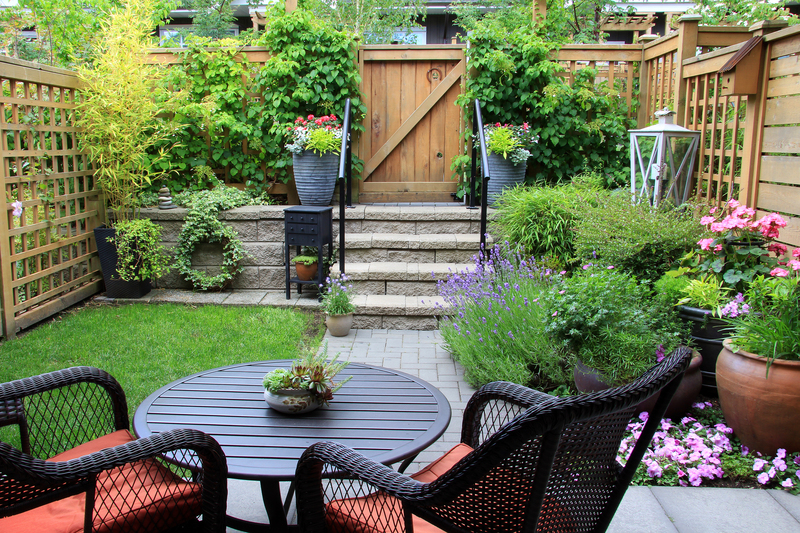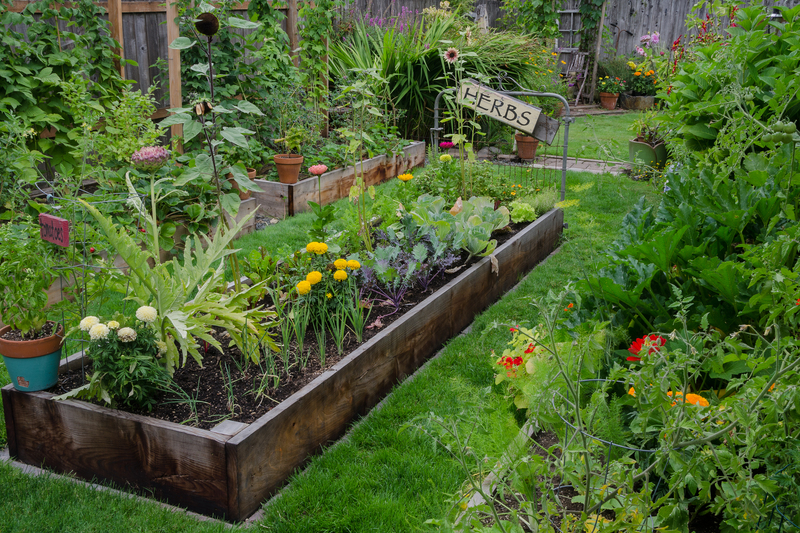Rooted in Change: Gardens as Climate Advocates
Posted on 03/09/2025
Rooted in Change: Gardens as Climate Advocates
In today's rapidly changing world, environmental concerns are at the forefront of global conversations. As individuals and communities seek ways to combat climate change, gardens and green spaces have become powerful tools for climate advocacy. More than just beautiful landscapes, gardens are now recognized as climate solutions rooted in nature, sustainability, and hope for future generations. In this comprehensive article, we'll explore how gardens act as climate advocates, the science behind their impact, and practical steps for anyone to begin their journey as a climate-conscious gardener.

Understanding the Role of Gardens in Climate Action
Why Gardens Matter in the Face of Climate Change
Many may associate gardens with recreation and relaxation, but their significance runs much deeper. Gardens are ecosystems teeming with life, capable of influencing local climates, sequestering carbon, supporting biodiversity, and reducing environmental footprints. As climate advocates, gardens operate on multiple levels:
- Carbon Sequestration: Through plants, gardens absorb atmospheric carbon dioxide during photosynthesis, helping to mitigate greenhouse gas emissions.
- Biodiversity Hubs: Gardens provide sanctuary for pollinators, birds, and other wildlife, fortifying ecological resilience.
- Urban Cooling: Vegetated spaces reduce the "heat island" effect seen in cities, lowering temperatures and improving air quality.
- Soil Regeneration: Sustainable gardening practices enhance soil health and increase its ability to store carbon.
- Community Engagement: Climate gardens inspire individuals to take environmental action and spread awareness.
With these multifaceted benefits, gardens truly stand as advocates for the climate, rooting change at the ground level.
The Science of Gardens and Climate Mitigation
How Do Gardens Sequester Carbon?
At the heart of climate gardening is photosynthesis, the process by which plants absorb carbon dioxide (CO2) from the atmosphere, convert it to energy, and store the carbon in their tissues and roots. This natural "carbon sink" process is particularly potent when gardens are planted densely, feature perennial species, and include trees, shrubs, and deep-rooted plants.
- Trees and shrubs: These woody plants store carbon for decades. Urban forests and backyard orchards are excellent for long-term sequestration.
- Perennial flowers and grasses: Plants that return year after year develop robust root networks, enhancing soil structure and carbon storage.
- Soil: Soil itself can hold vast amounts of carbon, especially when managed with no-till practices, composting, and cover crops.
By fostering diverse and healthy gardens, individuals can contribute to climate mitigation in their own communities.
Biodiversity: The Backbone of a Resilient Climate Garden
Biodiversity is the variety of life in all its forms. A diverse garden ecosystem can adapt to changing weather patterns, resist pests, and recover from disturbances. Biodiversity-rich gardens:
- Support beneficial insects such as bees, butterflies, and ladybugs, improving pollination and pest control.
- Encourage healthy soil microbiomes that bolster plant growth and carbon storage.
- Act as microhabitats for amphibians, birds, reptiles, and small mammals facing habitat loss due to urbanization.
A garden with many species is better equipped to withstand climate change and serves as a living advocate for biodiversity itself.
Climate-Smart Gardening: Best Practices
Anyone can play a role in climate gardening. By making intentional choices, gardeners can maximize the climate benefits of any space, from small balconies to sprawling community plots.
Key Strategies for Creating a Climate-Resilient Garden
- Choose Native Plants: Native species are adapted to local climates, need less water, and support local wildlife.
- Plant Trees and Shrubs: Adding woody plants boosts carbon storage and offers habitat for birds and insects.
- Minimize Lawn Area: Lawns require mowing, watering, and fertilizing, all of which increase emissions. Replace turf with pollinator gardens, meadows, or food gardens.
- Compost Organic Waste: Recycling yard and kitchen waste into compost returns carbon to the soil and reduces methane emissions from landfills.
- Use Water Wisely: Install rain barrels, mulch beds, and drip irrigation to conserve water and prevent runoff.
- Avoid Chemicals: Chemical fertilizers and pesticides harm soil health and biodiversity. Opt for organic and biological controls.
- Encourage Diversity: Incorporate a mix of annuals, perennials, vegetables, herbs, and flowers to attract a wide array of pollinators and beneficial organisms.
Designing a Garden for Climate Advocacy
A climate advocate's garden is designed with purpose, aiming for environmental stewardship over mere aesthetics.
- Layer Plants: Mimic natural forests by incorporating layers (canopy, understory, groundcover) to maximize habitat and carbon storage.
- Provide Water and Shelter: Small ponds, bird baths, and brush piles make your garden a haven for wildlife adjusting to shifting habitats.
- Grow Food: Edible gardens reduce food miles and empower individuals to eat sustainably, further reducing their carbon footprint.
- Participate in Citizen Science: Track birds, pollinators, and plant phenology to contribute valuable data on climate change's impact on local ecosystems.
The Social Impact: Gardens Cultivating Climate Awareness
Community Gardens: Collective Climate Power
Community gardens are more than shared plots; they are powerful agents of climate advocacy and social change. By uniting neighbors around sustainable practices, these spaces:
- Reduce food insecurity and food miles.
- Educate residents--both young and old--about climate challenges and solutions.
- Increase urban green space, supporting pollinators and reducing extreme heat.
- Foster a spirit of stewardship, inspiring further environmental actions in the community.
Through workshops, seed swaps, and educational signage, gardens as climate advocates help cultivate a deeper understanding of environmental responsibility.
School Gardens: Nurturing the Next Generation of Climate Stewards
Integrating gardens into school curricula allows students to connect theory with practice. Hands-on learning about growing food, conserving water, and supporting wildlife can:
- Inspire lifelong environmental values.
- Provide STEM learning opportunities in ecology, biology, and climate science.
- Promote community engagement and civic responsibility.
By involving youth, gardens become living classrooms for climate advocacy, inspiring the leaders of tomorrow to be rooted in change.
Global Movements: Gardens Making a World of Difference
Urban Greening Initiatives
Cities across the globe are recognizing the value of green infrastructure--rooftop gardens, vertical walls, urban parks, and community orchards--not only to beautify urban environments, but to fight climate change:
- London's "National Park City" project aims to make the capital greener, wilder, and healthier by promoting public gardens and natural spaces.
- Singapore has turned its skyline into a network of vertical gardens and green roofs, cooling the city and improving air quality.
- North American cities are integrating edible landscapes and pollinator pathways into municipal planning, promoting food security and biodiversity.
These projects prove that gardens can be global climate advocates, reshaping how societies interact with nature.
The Role of Permaculture and Regenerative Agriculture
Permaculture and regenerative gardening go beyond sustainability--they actively improve ecosystems. Principles such as no-till gardening, polycultures, and nutrient cycling:
- Increase soil organic matter and sequester more carbon.
- Build climate resilience by mimicking natural ecosystems.
- Restore degraded landscapes and improve food security worldwide.
From the Transition Towns movement to the spread of backyard permaculture, these approaches amplify the message that gardens hold the power to heal climate wounds.
Challenges and Opportunities in Climate Advocacy Gardening
While gardens offer tremendous opportunities for climate action, several challenges remain:
- Access to Land: Not all communities have equal access to green space. Creative solutions like container gardening and rooftop gardens can help bridge this gap.
- Climate Extremes: Extreme heat, drought, or storms can threaten garden sustainability. Choosing resilient plants and adopting water-wise practices will be key.
- Knowledge Gaps: Sharing knowledge through workshops, online forums, and mentorship programs helps new gardeners become climate advocates.
Opportunities abound if gardeners, policymakers, and organizations work together. Local governments can support urban greening, schools can integrate climate science gardens, and individuals can become mentors, sharing seeds and wisdom.
The Future of Gardens as Climate Advocates
The movement for climate-conscious gardening is growing. As the world faces ever-increasing environmental challenges, gardens stand as symbols of resilience and hope. Looking ahead, the future lies in:
- Expanding community gardening initiatives in underserved neighborhoods.
- Harnessing technology, such as smart irrigation and soil sensors, to make gardens more climate-resilient.
- Building alliances between gardeners, conservationists, and policymakers to ensure that gardens have a voice in climate action discussions.
- Continuing to educate the public about the climate impact of sustainable gardening.
As more people get involved, the cumulative benefits grow--more carbon captured, more urban cooling, and more wildlife habitat preserved. In the coming decades, gardens will be at the root of lasting environmental change.

Practical Steps: How You Can Be a Garden Climate Advocate
- Assess Your Space: Whether you have a yard, balcony, or windowsill, every bit of green counts.
- Invest in Soil Health: Use compost, mulch, and avoid disturbing the soil to help store carbon and support biodiversity.
- Grow Climate-Resilient Crops: Consider drought-tolerant varieties and perennial vegetables that adapt well to local conditions.
- Participate in Local Events: Attend gardening workshops, join environmental organizations, or volunteer in community gardens to share knowledge and enthusiasm.
- Advocate for Green Policy: Support initiatives that expand urban green spaces, community gardens, and climate-friendly landscaping in public spaces.
Conclusion: Rooted In Change, Gardens Lead the Way
In a world seeking answers to the climate crisis, gardens offer both practical solutions and inspiration. By nurturing plants, fostering biodiversity, cooling cities, and bringing people together, gardens act as living, breathing climate advocates. They remind us that even the smallest patch of earth can make a difference. The movement of gardens as climate advocates is rooted in hope, sustained by action, and has the power to help shape a sustainable, climate-resilient future for all.
Ready to get your hands dirty? By starting or supporting a climate-friendly garden, you join a global initiative--one seed, one plant, one garden at a time. Be part of the change. Be rooted in it.

